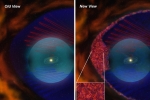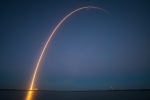Ribbon Of Charged Particles At Solar System's Edge Acts Like A Wind Sock For Interstellar Magnetism

About 10 billion miles away lies a ribbon of highly charged particles. Scientists know so little about it that it hardly seems to have a name; most refer to it as the IBEX ribbon, after the Interstellar Boundary Explorer spacecraft that discovered it in 2009.
Like Us on Facebook
But little by little, scientists sifting through various data from ground- and space-based observations are beginning to learn more about what happens at the edge of the heliosphere, a kind of sun-made snow globe in which our solar system floats. New findings released Thursday from the Southwest Research Institute and published in the journal Science suggest the magnetic ribbon behaves almost like a wind sock, orienting itself according to magnetic forces coming in from the surrounding galaxy.
It's a breakthrough for people who study this stuff, and for the rest of us, it's a glimpse into a nether region seldom considered: interstellar space. Our solar system is floating through the Milky Way galaxy, about halfway out from the center, at 60,000 mph. For life on Earth to exist, an infinite number of galactic and solar system mechanisms must be working properly. One of them is the force field at the edge of the heliosphere that shelters all of us from supercharged particles that zip to and fro in the space between the stars. (These particles, or cosmic rays, are caused by stars blowing up.) Without this barrier, these rays would fry our ozone.
Again, we can thank the sun for that life-giving protection — it's caused by a magnetic field that looks like foam. Each magnetized bubble of this foam is about 100 million miles wide and shields us from cosmic rays. But we've never really known much about the rays themselves: how strong they are, where they come from, how often they appear. Basically, we didn't know what space was like beyond our bubble.
For the last five years, however, scientists have known about this mysterious ribbon thing, the IBEX ribbon, which is situated somewhere beyond the heliosphere. It looks kind of like a halo and comprises charged particles of varying energetic strengths. (You can read more about the discovery of the ribbon here.)
"It seems like we now have good independent confirmation that the IBEX ribbon is ordered by the interstellar magnetic field, and we know that Voyager 1 takes fairly good measurements," lead physicist Nathan Schwadron, of the University of New Hampshire, told Space.com. They found that the ribbon re-aligns itself roughly perpendicular to the direction of galactic magnetism. Cosmic rays tend to come at us along the galactic magnetism, like twigs carried downstream. Some are calling it a "roadmap" to the galaxy — a barometer of space beyond.
© 2012 iScience Times All rights reserved. Do not reproduce without permission.

25 Year Study Reveals Eco-Farming To Be Economically Feasible And Sustainable

How Methane-Producing Microbes Caused The Largest Mass Extinction The World Has Ever Seen

Terrifying Animatronic Robot Dances To 'Blurred Lines,' Causes Nightmares [VIDEO]

Scientists Demonstrate Three-Way Quantum Communication: What's Faster Than The Speed Of Light?

Woolly Mammoth DNA To Be Cloned, Then Joined With Elephant DNA To Create New Creature

Oculus Rift Headset Will Take You On A Trip To Space, All From The Comfort Of Your Couch



![How to Turn Your Tap Water Faucet Into a Coffee Spout [VIDEO]](../../../cdn-sub/data/thumb/mainpage/6005-150100-coffee.jpg)

